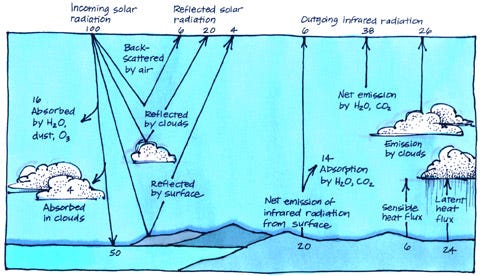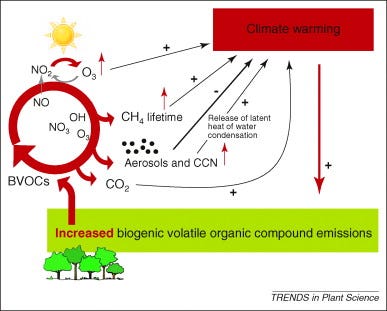Will greening due to CO2 fertilization mitigate future warming?
New study suggests biogenic volatile organic compounds play an important role in cloud formation.
Water vapor, clouds, and climate change…
Water vapor is the most abundant and dominant greenhouse gas in the Earth's atmosphere. When considering the natural greenhouse effect (excluding the contributions from human-induced emissions of gases like CO2, methane, and others), water vapor is responsible for roughly 60-80% of the greenhouse effect.
Clouds play a complex and critical role in the Earth's climate system, influencing both the absorption and reflection of solar radiation and affecting the Earth's radiative balance. Their role in climate change and the challenges in modeling them are intertwined and rooted in the multifaceted nature of clouds.
Clouds can both cool the planet and warm it. On one hand, clouds reflect incoming solar radiation back into space (albedo effect). This is particularly true for thick, bright clouds like cumulus or stratocumulus. By doing so, they have a cooling effect on the Earth's surface. On the other hand, clouds can also act as insulators, trapping outgoing infrared radiation from the Earth's surface and warming the lower atmosphere in a process analogous to the greenhouse effect. Typically, this warming role is performed by higher, thinner clouds, such as cirrus clouds.
The challenge in climate modeling stems from the diverse nature of clouds: they come in various types, altitudes, and lifespans, and are affected by and can affect atmospheric dynamics and thermodynamics at multiple scales.
In addition, cloud formation depends on the presence of tiny particles called aerosols, which serve as nuclei for condensation. The sources and behaviors of aerosols are also complex and add another layer of complication to modeling efforts.
Resolving clouds in climate models requires a fine-scale representation, but many global models work at resolutions where small-scale cloud processes, such as convection and cloud formation, aren't directly captured. Instead, they rely on parameterizations – simplified representations of these processes based on observations or more detailed, smaller-scale models. These parameterizations are a source of uncertainty in global climate models. If clouds are not accurately represented, it can lead to inaccuracies in predicting temperature, precipitation, and other aspects of the climate.
The interplay between clouds and climate change further complicates the picture. As global temperatures rise, the behavior and distribution of clouds might change, affecting feedback loops in the climate system. For instance, if a warming world results in fewer low-altitude clouds, there may be a decrease in the albedo effect, leading to further warming.
In essence, while clouds are undeniably crucial in the climate system, their multifaceted interactions and inherent complexity at various scales make them one of the most challenging components to model accurately in climate predictions. Advances in computing power and observational data, alongside refined modeling techniques, continue to improve our understanding and representation of clouds in climate models.

The Intergovernmental Panel on Climate Change (IPCC) has discussed the role of clouds and cloud nucleation in climate change extensively in its assessment reports, given the importance and complexity of clouds in the climate system.
The IPCC acknowledges that clouds represent one of the most significant sources of uncertainty in climate projections. Cloud processes, cloud feedbacks, and their interactions with radiation are intricate, and multifaceted, and can operate on various scales.
The reports discuss both positive and negative cloud feedbacks, such as how low clouds may have different (often cooling) effects compared to high clouds (often warming). The overall impact of these feedbacks on climate sensitivity remains a topic of ongoing research, and the net feedback of all cloud types combined is still uncertain.
Aerosols play a crucial role in cloud nucleation, acting as cloud condensation nuclei (CCN) around which water vapor condenses to form cloud droplets. The IPCC has identified several key ways in which aerosols influence climate:
Direct effect: Aerosols scatter and absorb solar and infrared radiation, affecting the Earth's radiative balance directly.
Cloud albedo effect: Increased aerosol concentrations can lead to more, but smaller, cloud droplets, making clouds more reflective (increasing their albedo). This effect tends to cool the Earth's surface.
Cloud lifespan effect: Changes in droplet size, due to aerosol influence, can affect the lifespan and precipitation rates of clouds.
The IPCC acknowledges the difficulties in modeling clouds. Representing cloud processes in climate models requires simplifications, called parameterizations. Given the range of scales at which cloud processes occur, from microscopic cloud droplet formation to large cloud systems spanning hundreds of kilometers, simulating these processes is inherently challenging.
Plants and cloud formation…
Plants release a variety of volatile organic compounds (VOCs), including hydrocarbons like isoprene and terpenes. These biogenic VOCs (BVOCs) play a role in atmospheric chemistry and can influence cloud formation.
When BVOCs are emitted into the atmosphere, they can undergo oxidation processes, often initiated by reactions with hydroxyl radicals (OH), ozone (O₃), and nitrate radicals (NO₃). This oxidation transforms BVOCs into lower-volatility compounds, which can then condense onto existing aerosol particles or nucleate to form new aerosol particles. These particles, known as secondary organic aerosols (SOAs), can act as cloud condensation nuclei (CCN) or ice-nucleating particles (INPs).
As more aerosol particles form or grow due to the condensation of oxidation products of BVOCs, there are more potential nuclei available for cloud droplet formation. An increase in CCN can influence cloud properties. For example, with more CCN, cloud droplets tend to become smaller but more numerous. This can increase the cloud's albedo, reflecting more sunlight and having a cooling effect on the Earth's surface.
Smaller, more numerous cloud droplets take longer to coalesce into raindrops, potentially prolonging the lifespan of clouds. Longer-lived clouds can lead to more prolonged and broader cloud cover, further influencing the radiative balance.
There's a fascinating interplay between plants, the atmosphere, and climate. As the climate warms, plants might emit more BVOCs. The resultant SOAs could impact cloud properties, potentially counteracting some of the warming.

However, the magnitude and significance of such feedback loops are areas of ongoing research and are largely ignored by the IPCC. In the AR6 WGI report the IPCC states:
Keep reading with a 7-day free trial
Subscribe to Irrational Fear to keep reading this post and get 7 days of free access to the full post archives.





